Greetings dear friends of the Hive platform, welcome back to my blog dedicated to the study and dissemination of material related to the fascinating world of arthropods. In the present entry will describe a family of arachnids that has really interesting morphological characteristics; in turn, this publication will also be directed to my participation in the community contest Insects of the world, promoted by the friend @adalger, although a spider is not an insect I hope it will be useful for the contest.
Saludos estimados amigos de la plataforma Hive, sean todos bienvenidos nuevamente a mi blog dedicado al estudio y a la difusión de material referente al fascinante mundo de los artrópodos. En la presente entrada se describirá a una familia de arácnidos que posee características morfológicas realmente interesantes; a su vez, esta publicación también estará dirigida a mi participación en el concurso de la comunidad Insects of the world, promovida por el amigo @adalger, aunque una araña no es un insecto espero que sirva para la ocasión.
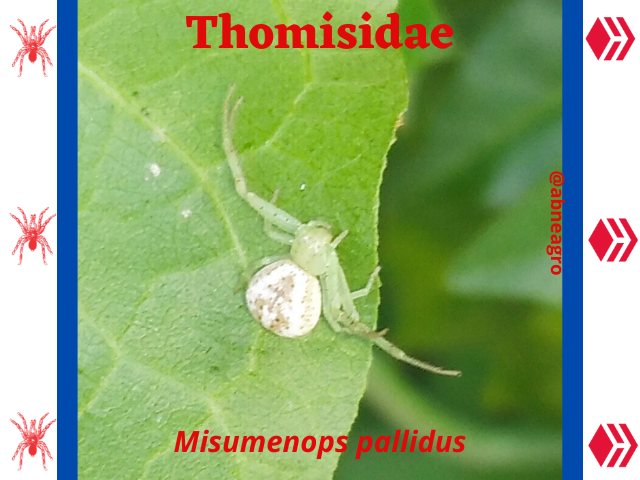
The members of the order Araneae are part of those invertebrates that possess truly incredible qualities and characteristics, their intelligence and the great agility with which these arthropods are endowed has been a source of admiration and study by many professionals and amateurs in the area of arachnology and even in entomology itself.
Spiders are the largest and most diverse group that exists within the arachnid world, having several families spread across all continents, of which some are more popular than others; so it is virtually impossible not to know those small jumping spiders of the family Salticidae or those less mobile and long-legged that often fill every corner of our homes with their webs, these would be those of the family Pholcidae. These 2 families of spiders mentioned above, have adapted to live in our spaces, but without depending at any time on our species, which makes them synanthropic species; while others can live among the plants in our gardens, an example would be those of the family Araneidae as the genus Argiope, or those of the family Thomisidae, which will be discussed in the next article.
Los integrantes del orden Araneae forman parte de aquellos invertebrados que poseen cualidades y características realmente increíbles, su inteligencia y la gran agilidad de las que están dotados estos artrópodos ha sido motivo de admiración y estudio por parte de muchos profesionales y aficionados en el área de la aracnología e incluso en la misma entomología.
Las arañas son el grupo más grande y diverso que existe dentro del mundo de los arácnidos, teniendo diversas familias repartidas por todos los continentes, de las cuales algunas son más populares que otras; por lo que resulta prácticamente imposible no conocer a esas pequeñas arañas saltarinas de la familia Salticidae o aquellas menos móviles y de patas largas que frecuentemente llenan cada rincón de nuestro hogares con sus telarañas, estas serian las de la familia Pholcidae. Estas 2 familias de arañas mencionadas anteriormente, se han adaptado para poder vivir en nuestros espacios, pero sin depender en ningún momento de nuestra especie, lo que las convierte en especies sinantrópicas; mientras que otras pueden vivir entre las plantas de nuestros jardines, un ejemplo serian las de la familia Araneidae como el género Argiope, o las de la familia Thomisidae, sobre las cuales se hablará en el siguiente artículo.
.png)
The family Thomisidae has more than 120 genera, and all its species are commonly known as crab spiders, due to the particular legs they have, in which the first pairs are extremely long compared to the hind legs. One of its most debated genera by experts is the Misumenops, which has species that have been actively removed from other genera and annexed to the aforementioned (Misumenops), which usually generates much confusion when identifying them, in addition to many of its specimens are very similar to each other, having only small differences in certain color patterns they have in certain areas of their bodies, so their observation must be very detailed to avoid making mistakes when identifying them.
La familia Thomisidae posee más de 120 géneros, siendo todas sus especies conocidas comúnmente como arañas cangrejo, debido a las particulares patas que poseen, en las cuales se aprecia que los primeros pares son extremadamente largos a comparación de las patas posteriores. Uno de sus géneros más debatidos por los expertos es el Misumenops, el cual posee especies que han sido removidos de manera activa de otros géneros y anexados al ya mencionado (Misumenops), lo que suele generar mucha confusión a la hora de identificarlos, además de que muchos de sus especímenes son muy parecidos entre si, teniendo tan solo pequeñas diferencias en determinados patrones coloridos que poseen en ciertas zonas de sus cuerpos, por lo que su observación debe ser muy detallada para no cometer errores a la hora de identificarlos.
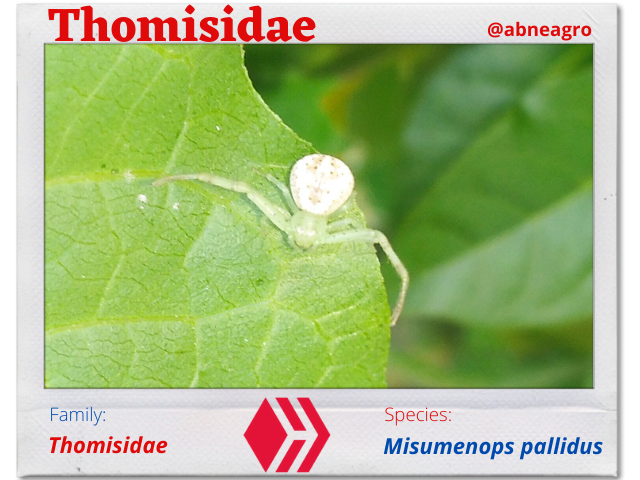.png)
The genus Misumenops currently has an estimated 55 described species, a number that is quite variable because each time new specimens can be added, and as is often the case with arthropods in general, discoveries of new species are constantly made, so there may still be many waiting to be classified taxonomically. You can see the active species of that family (Thomisidae) in the World spider catalog, a website that is constantly updated with taxonomic and geographic data on spiders.
On the other hand, the species shown in this publication corresponds to a Misumenops pallidus female, the identification of this beautiful specimen was not a simple task, since there are many species that are similar to this one, so that, it was necessary to compare several species of other genera to discard one by one, detailing colors, sizes and not forgetting the geographical distribution, which is a key point to discard species, since we must remember that there are specimens that are only present in certain countries or regions (endemic), while others may be widely distributed throughout the world (cosmopolitan).
El género Misumenops posee en la actualidad un estimado de 55 especies descritas, un número que es bastante variable debido a que cada vez se le pueden añadir nuevos ejemplares, y como suele ocurrir con los artrópodos en general, constantemente se hacen descubrimientos de nuevas especies, por lo que aún pueden haber muchas a las espera de ser clasificadas a nivel taxonómico. Puedes ver las especies activas de dicha familia (Thomisidae) en el World spider catalog, sitio web que está en constante actualización en lo que respecta a datos taxonómicos y geográficos sobre arañas.
Por otro lado, la especie mostrada en esta publicación corresponde a una Misumenops pallidus hembra, la identificación de este hermoso ejemplar no fue una tarea sencilla, ya que hay muchas especies que son semejantes a esta, de manera que, hubo necesidad de comparar a diversas especies de otros géneros para ir descartando una a una, detallando colores, tamaños y sin olvidar la distribución geográfica, la cual es un punto clave para descartar especies, ya que debemos recordar que hay ejemplares que solo están presente en determinados países o regiones (endémicas), mientras que otras pueden estar ampliamente distribuidas por el mundo (cosmopolitas).
.png)
Most of these arachnids have unique colors that make them very striking to the naked eye, although their coloration is usually determined by the place where they live, in the case of members of the family Thomisidae, they are spiders that are part of small ecosystems that form on plant organisms (plants); for this reason their predominant colors are usually green, white or yellow.
Gran parte de estos arácnidos poseen colores únicos que los hacen muy llamativos a simple vista, aunque por lo general su coloración va determinada por el lugar en donde hacen vida, en el caso de los miembros de la familia Thomisidae, son arañas que forman parte de los pequeños ecosistemas que se forman sobre los organismos vegetales (plantas); por esta razón sus colores predominantes suelen ser el verde, blanco o amarillo.
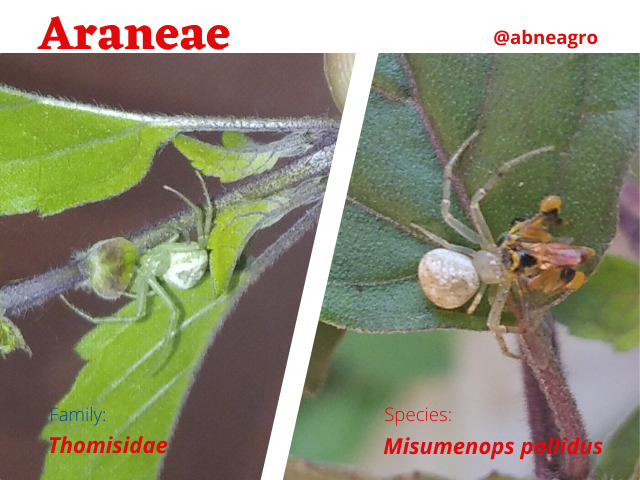.png)
This type of spider does not use webs to trap its prey, but has adapted to live among the flowers of plants, where it waits for a pollinator or other insect to be attracted to the plant's flower and, upon approaching, the arthropod is quickly captured by the spider. This arachnid is endowed with venomous glands attached to its chelicerae; however, this venom is completely harmless to humans and is designed to paralyze the small organism that will be its food.
Este tipo de araña no emplea telarañas para atrapar a sus presas, en su lugar se han adaptado para vivir entre las flores de las plantas, lugar en donde esperan a que algún polinizador u otro insecto se vea atraído por la flor de la planta y al acercarse, es capturado rápidamente por la araña. Este arácnido está dotado de unas glándulas venenosas unidas a sus quelíceros; sin embargo, este veneno es completamente inofensivo para el humano y está diseñado para paralizar al pequeño organismo que será su alimento.
.png)
On the other hand, arachnids have a body divided into two segments, the prosoma and the opisthosoma (abdomen). Similarly, this specimen has a translucent coloration in its legs and prosoma, which allows it to camouflage with its environment, while its opisthosoma has a white hue, being able to appreciate in its dorsal region a series of quite striking patterns with that color (white).
The differences or sexual dimorphism between the female and the male is very marked, being the males much smaller than the females, also the opisthosoma has large size in females.
Por otro lado, los arácnidos poseen el cuerpo dividido en 2 segmentos, estos son el prosoma y el opistosoma (abdomen). De igual manera, este ejemplar tiene una coloración translúcida en sus patas y el prosoma, lo que le permite poder camuflarse con su entorno, mientras que su opistosoma posee una tonalidad blanca, lográndose apreciar en su región dorsal una serie de patrones bastante llamativos con dicho color (blanco).
Las diferencias o el dimorfismo sexual entre la hembra y el macho es muy marcado, siendo los machos mucho más pequeños que las hembras, además el opistosoma posee gran tamaño en las hembras.
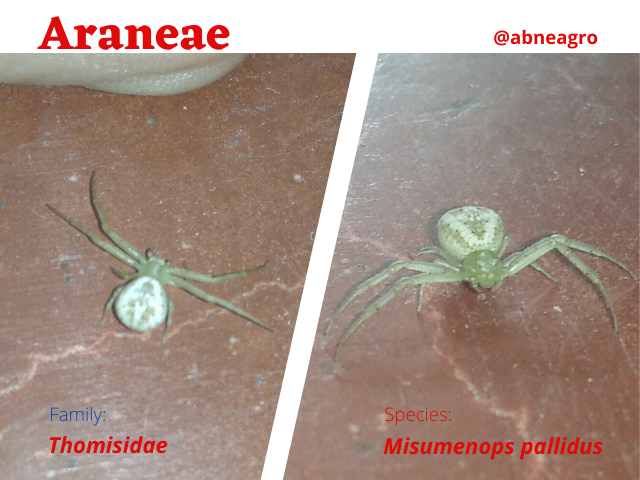.png)
These spiders are very easy to find among the plants in the garden, the species that can be seen will depend on the country or region where you are. In plants spiders find an ideal place to live, since they are places that are frequently visited by a variety of arthropods, so these arachnids have a constant food source with which they can stay active in the ecosystem.
When members of the family Thomisidae are waiting for prey, they usually keep their first and second pair of legs open, due to the length of these limbs and the position in which they keep them, they resemble crabs, and often these arachnid specimens move laterally to walk, in the same way that crabs do, because of these particular characteristics and behavior, these are called "crab spiders".
Estas arañas son muy fáciles de encontrar entre las plantas del jardín, las especies que se pueden apreciar ya dependerá del país o de la región en donde te encuentres. En las plantas las arañas encuentran un lugar ideal para poder vivir, ya que son lugares que frecuentemente son visitados por una gran variedad de artrópodos, por lo que estos arácnidos tienen una fuente de alimento constante con la que pueden mantenerse activas en el ecosistema.
Cuando los miembros de la familia Thomisidae se encuentran a la espera de alguna presa, suelen mantener su primer y segundo par de patas abiertos, debido a lo largas que son estas extremidades y a la posición en las que las mantienen, se asemejan a los cangrejos, además de que muchas veces estos especímenes arácnidos se mueven de manera lateral para caminar, de la misma forma en la que lo hacen los cangrejos, debido a estas particulares características y conducta, estas son llamadas "arañas cangrejo".

All the characteristics of these spiders make them unique, the hunting method they use is very original and effective, all this has been achieved after years of evolution, which makes them animals that deserve respect and admiration from us; likewise, we must remember that they are essential organisms for the control of many insects that can have a negative impact on ecosystems when their populations get out of control, something that is very common due to climate change and the modification we give to natural areas for our benefit, so it is always necessary to observe the possible consequences of our actions.
Todas las características de estas arañas las hacen únicas, el método de caza que emplean es muy original y eficaz, todo esto lo han logrado tras años de evolución, lo que las hace ser animales que merecen respeto y la admiración de nuestra parte; de igual manera, debemos recordar que son organismos esenciales para el control de muchos insectos que pueden llegar a tener un impacto negativo sobre los ecosistemas cuando sus poblaciones se descontrolan, algo que es muy habitual por el cambio climático y por la modificación que le damos a los espacios naturales para nuestro beneficio, por lo que siempre es necesario observar las posibles consecuencias que originan nuestros actos.

All photos presented in this publication belong to the author @abneagro. The photos were taken with a Redmi 8A mobile device and edited with the Canva application.
Todas las fotografías presentadas en esta publicación pertenecen al autor @abneagro. Las fotos fueron realizadas con un dispositivo móvil Redmi 8A y editadas con la aplicación Canva.

Some references:

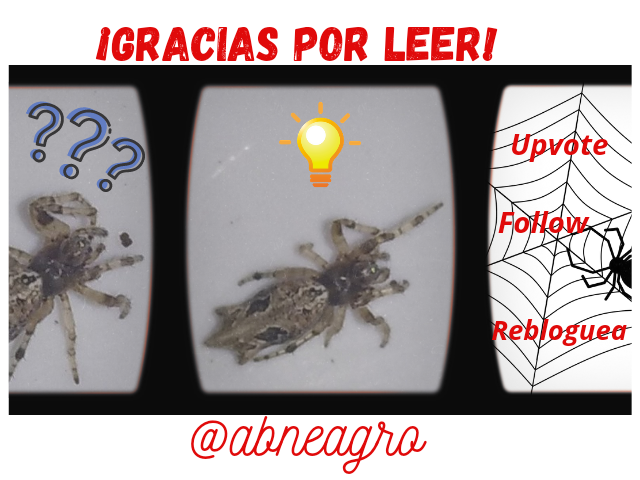
Great post about this species .. as your other contributions it is highly detailed, informative and educative .. excellent word 😍 .. and another entry to the DNA "Identified and Described" species library .. can't wait to see more from you 😁
Thank you very much for the support @adalger, I am glad again that my writings are to your liking. As I had already mentioned in previous comments, arthropods are an active part of my day to day, in Agronomy it is important to know these invertebrates to know how they benefit or harm within the productive environment, that way you can determine the type of management that can be given to them to live in harmony with them, since we share the same space as them on this planet. Greetings!
Buenas. Su post ha sido propuesto para ser votado a lo largo del día por el witness @cervantes. Un saludo
Muchas gracias por el apoyo amigos de @cervantes.
Nicely presented with these small species, each has a specific reason being where they are, keeping our world in balance.
That's right, every species, no matter how small it is, is necessary for the proper functioning of ecosystems, thank you very much for your support, greetings!
Always worried when seeing the rate we take up land with little thought, so many smaller mammal species are disappearing in our region. Thankfully we have plenty birds and insects still around.